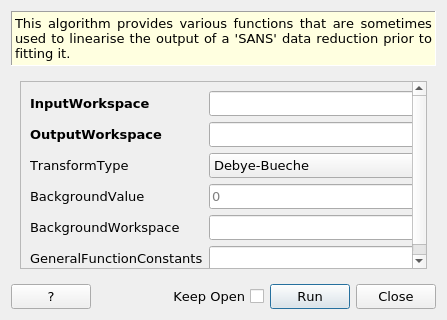\(\renewcommand\AA{\unicode{x212B}}\)
IQTransform v1¶

IQTransform dialog.¶
Summary¶
This algorithm provides various functions that are sometimes used to linearise the output of a ‘SANS’ data reduction prior to fitting it.
Properties¶
Name |
Direction |
Type |
Default |
Description |
|---|---|---|---|---|
InputWorkspace |
Input |
Mandatory |
The input workspace must be a distribution with units of Q |
|
OutputWorkspace |
Output |
Mandatory |
The name of the output workspace |
|
TransformType |
Input |
string |
Mandatory |
The name of the transformation to be performed on the workspace. Allowed values: [‘Debye-Bueche’, ‘General’, ‘Guinier (rods)’, ‘Guinier (sheets)’, ‘Guinier (spheres)’, ‘Holtzer’, ‘Kratky’, ‘Log-Log’, ‘Porod’, ‘Zimm’] |
BackgroundValue |
Input |
number |
0 |
A constant value to subtract from the data prior to its transformation |
BackgroundWorkspace |
Input |
A workspace to subtract from the input workspace prior to its transformation.Must be compatible with the input (as for the Minus algorithm). |
||
GeneralFunctionConstants |
Input |
dbl list |
A set of 10 constants to be used (only) with the ‘General’ transformation |
Description¶
This algorithm is intended to take the output of a SANS reduction and apply a transformation to the data in an attempt to linearise the curve. Optionally, a background can be subtracted from the input data prior to transformation. This can be either a constant value, another workspace or both. Note that this expects a single spectrum input; if the input workspace contains multiple spectra, only the first will be transformed and appear in the output workspace.
A SANS reduction results in data in the form I(Q) vs Q, where Q is Momentum Transfer and I denotes intensity (the actual unit on the Y axis is 1/cm). These abbreviations are used in the descriptions of the transformations which follow. If the input is a histogram, the mid-point of the X (i.e. Q) bins will be taken. The output of this algorithm is always point data.
Transformation Name |
Y |
X |
|---|---|---|
Guinier (spheres) |
\(\ln (I)\) |
\(Q^2\) |
Guinier (rods) |
\(\ln (IQ)\) |
\(Q^2\) |
Guinier (sheets) |
\(\ln (IQ^2)\) |
\(Q^2\) |
Zimm |
\(\frac{1}{I}\) |
\(Q^2\) |
Debye-Bueche |
\(\frac{1}{\sqrt{I}}\) |
\(Q^2\) |
Holtzer |
\(I \times Q\) |
\(Q\) |
Kratky |
\(I \times Q^2\) |
\(Q\) |
Porod |
\(I \times Q^4\) |
\(Q\) |
Log-Log |
\(\ln(I)\) |
\(\ln(Q)\) |
General [*] |
\(Q^{C_1} \times I^{C_2} \times \ln{\left( Q^{C_3} \times I^{C_4} \times C_5 \right)}\) |
\(Q^{C_6} \times I^{C_7} \times \ln{\left( Q^{C_8} \times I^{C_9} \times C_{10} \right)}\) |
Usage¶
Example - Zimm transformation:
x = [1,2,3]
y = [1,2,3]
input = CreateWorkspace(x,y)
input.getAxis(0).setUnit("MomentumTransfer")
input.setDistribution(True)
output = IQTransform(input, 'Zimm')
print('Output Y: {}'.format(output.readY(0)))
print('Output X: {}'.format(output.readX(0)))
Output:
Output Y: [ 1. 0.5 0.33333333]
Output X: [ 1. 4. 9.]
Example - Zimm transformation and background:
x = [1,2,3]
y = [1,2,3]
input = CreateWorkspace(x,y)
input.getAxis(0).setUnit("MomentumTransfer")
input.setDistribution(True)
output = IQTransform(input, 'Zimm', BackgroundValue=0.5)
print('Output Y: {}'.format(output.readY(0)))
print('Output X: {}'.format(output.readX(0)))
Output:
Output Y: [ 2. 0.66666667 0.4 ]
Output X: [ 1. 4. 9.]
Example - General transformation:
import math
x = [1,2,3]
y = [1,2,3]
input = CreateWorkspace(x,y)
input.getAxis(0).setUnit("MomentumTransfer")
input.setDistribution(True)
constants = [2,2,0,0,math.e,3,0,0,0,math.e]
output = IQTransform(input, 'General', GeneralFunctionConstants=constants)
print('Output Y: {}'.format(output.readY(0)))
print('Output X: {}'.format(output.readX(0)))
Output:
Output Y: [ 1. 16. 81.]
Output X: [ 1. 8. 27.]
Categories: AlgorithmIndex | SANS
Source¶
C++ header: IQTransform.h
C++ source: IQTransform.cpp
